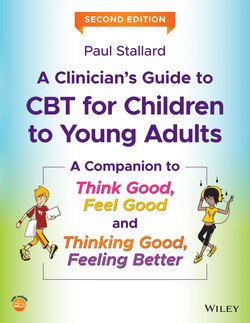Читать книгу A Clinician's Guide to CBT for Children to Young Adults - Paul Stallard - Страница 15
CBT with younger children
ОглавлениеWhilst CBT can routinely be used with children from the age of seven years, comparatively few studies have evaluated the effectiveness of CBT with children under the age of 12 (Ewing et al. 2015). Most studies tend to involve young adolescents aged 12–17. Randomised controlled trials evaluating CBT for the treatment of depression rarely include children under the age of 12 (Forti‐Buratti et al. 2016). For example, Yang et al. (2017) undertook a review and meta‐analysis of CBT for the treatment of depression in children (defined as under the age of 13) and identified only nine studies, with six of these being conducted before the turn of the century.
In terms of anxiety, a few specific programmes for young children have been developed. These include Being Brave (Hirshfeld‐Becker et al. 2010), Taming Sneaky Fears (Monga et al. 2015), and the school‐based universal prevention programme Fun Friends (Pahl & Barrett 2010). Results from these studies are limited but nonetheless encouraging.
A few researchers have developed and explored the effectiveness of CBT with young children with PTSD (Dalgleish et al. 2015; Salloum et al. 2016). For example, Scheeringa et al. (2011) reported the feasibility of a trauma‐focused CBT intervention with children aged three to six who had experienced a life‐threatening event and found a large reduction in PTSD symptoms at six months. Research with OCD is similarly limited, although once again the results are promising. In one of the few studies, Freeman et al. (2014) found that 72% of children aged five to eight with OCD were assessed as ‘much improved’ after completing a 14‐session family‐based CBT programme.
It cannot be assumed that because CBT is effective with young adolescents that it will also be effective with young children. Developmental factors need to be considered and the role of parents/carers requires careful attention. Nonetheless, although research is limited, the results are encouraging and are consistent with those obtained with older samples.
